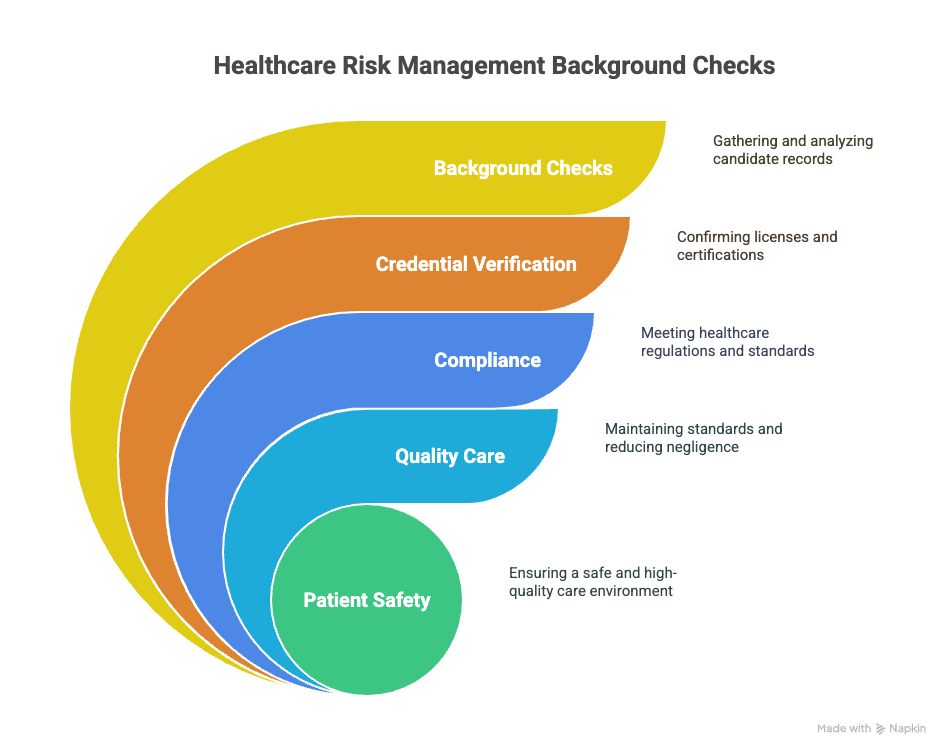In the complex and high-stakes environment of healthcare, managing risks effectively is crucial to ensuring patient safety and maintaining a trustworthy clinical workforce. One key aspect of risk management is integrating thorough background checks into the larger clinical risk strategy. This approach not only protects patients but also fortifies the hospital's reputation and operational integrity.
This guide provides an in-depth look at how embedding employment screening as a part of overall risk management can mitigate potential risks in healthcare settings. We'll explore the types of screenings necessary, legal considerations, implementation strategies, and how these practices contribute to clinical safety.
Key Takeaways
- Employment screening is crucial in healthcare to protect patients and maintain the organization's reputation.
- Background checks help identify potential risks by revealing past criminal activities and verifying credentials.
- Types of screenings include criminal background checks, credential verification, drug and alcohol tests, and reference checks.
- Legal compliance is essential when conducting screenings, ensuring non-discriminatory practices and respecting privacy.
- Overcoming challenges such as cost and time can improve the effectiveness of your screening processes, enhancing safety and care quality.
Introduction
Screening is a vital part of healthcare risk management. In environments where patient safety is paramount, understanding who you hire helps protect both patients and the organization itself. Effective employment screening identifies potential risks early on, safeguarding against issues like incompetence or misconduct that could harm patients or damage the facility's reputation.
This guide serves as a roadmap for integrating thorough employment screening into a broader risk management strategy. We'll focus on how screenings support compliance with healthcare standards and improve overall clinical safety. Comprehensive screening isn't just about checking boxes; it's about fostering trust and safety in your healthcare practice.
Understanding Risk Management Background Checks in Healthcare
Risk management background checks are crucial for healthcare settings. They involve gathering and analyzing a candidate’s past records, primarily to assess their suitability and identify any potential risks they might pose. This process isn't just about ticking boxes; it’s about safeguarding your institution and ensuring your staff provide the highest standard of care.
These checks play a pivotal role in healthcare risk management by unveiling past criminal activities, verifying credentials, and assessing employment history. For instance, discovering a prior conviction for medical malpractice can prevent hiring someone who might endanger patients. Such screenings are necessary to comply with healthcare regulations and standards. They help ensure only qualified and trustworthy professionals join your team.
Effective background checks significantly impact patient safety. By weeding out candidates with problematic histories, you protect patients from possible harm and improve the quality of care. For example, verifying licenses and certifications confirms that medical staff meet all required competencies, reducing the risk of professional negligence.

Think of these checks as your first line of defense in building a safe healthcare environment. Are you confident that your current screening processes effectively protect your patients and staff? Building a reliable system for background checks is an investment in long-term safety and quality care.
Types of Employment Screenings for Clinical Risk
Criminal background checks should be your first line of defense. These checks help unearth past behavior that might pose risks within a healthcare setting. Identifying individuals with a history of violence or fraud can prevent those dangers from entering your workplace. It’s about creating a safe environment for both patients and staff.
Credential verification is another pillar of effective screening. Confirming that medical licenses, certifications, and qualifications are valid ensures clinical competence. Hiring someone who lacks the necessary credentials can result in harm to patients and legal troubles for the facility. Always verify these details meticulously.
Drug and alcohol screening plays a crucial role in supporting workplace safety and maintaining productivity. Impaired professionals can lead to mistakes, accidents, and a compromised standard of care. Regular screening can help identify and manage these issues before they escalate.
Reference checks provide insights into an applicant's past performance and character. Speaking with previous employers gives you a better understanding of the applicant’s work ethic, reliability, and interpersonal skills. This step can uncover potential issues that a resume or interview might not reveal.

Each screening type contributes uniquely to mitigating risks in healthcare. Together, they form a comprehensive approach that upholds the safety and integrity of clinical environments. Are you using all these tools to protect your team and patients?
Legal Considerations in Background Checks
Adhering to legal frameworks is essential in the realm of employment screenings. In the U.S., the EEOC provides guidelines to ensure these checks are conducted fairly, maintaining compliance with federal laws. It's incumbent on you, as a healthcare provider, to align your screening procedures with these standards. This means any checks you perform must be relevant to the job and consistently applied across all candidates to avoid claims of discrimination.
Confidentiality and privacy are paramount. The information gathered through background checks is sensitive and should be handled with care. You need to safeguard this data, ensuring only authorized personnel access it. Implementing strict protocols for data storage and use will help maintain trust and legal compliance.
Discrimination concerns require that your hiring processes remain unbiased. If a background check raises an issue, consider its relevance to the position. For example, a decades-old minor offense may not pertain to one's ability to perform in a healthcare role. Establishing clear policies that evaluate the nature, timing, and severity of findings can guide fair decision-making, protecting both your organization and potential employees.
Integration of the Screening Process
Developing a Comprehensive Strategy
This involves aligning screening efforts with the hospital’s broader risk management goals. Consider what you're trying to protect: patient safety, hospital reputation, and overall operational integrity. Think of screening as a wide net cast to prevent any potential issues before they can arise. It starts with clear policies delineating what checks are performed and why they matter. These should be driven by both legal guidelines and the specifics of your facility’s needs.
Implementation Best Practices
Following industry best practices focus on integrating background checks seamlessly into existing processes. Workflows should be designed to ensure efficiency, maintaining momentum in the hiring process while still being thorough. Embedding these processes requires training staff on their importance, ensuring everyone knows their role in carrying out these checks effectively. Automation can assist—think of using software to standardize and speed up tasks without compromising thoroughness.
Continuous Monitoring and Evaluation
Focus on emphasizing the need to keep screening practices current. Laws change, and so does the healthcare landscape. Regularly review your screening protocols to keep up with new regulations and emerging industry risks. Conduct periodic audits to ensure compliance and identify areas for improvement. This feedback loop ensures that your strategy remains robust and effective, adapting to any changes that could affect the safety and integrity of your healthcare environment.
Challenges and Solutions
Implementing a robust background check program in healthcare settings is not without its hurdles. Limited resources, both in terms of time and money, can pose significant challenges. Balancing these constraints while maintaining thorough screening processes requires some careful planning.
One common obstacle is cost. Conducting comprehensive background checks, especially in large healthcare facilities with numerous hires, can become pricey. A potential solution is to prioritize roles that carry the most risk or have direct patient involvement. Initiating checks for these positions first ensures that those who may have the most impact on patient safety are properly vetted.
Time is another pressing issue. Background checks can delay hiring, leaving critical positions vacant. Streamlining this process with strategic planning pays off. Consider pre-scheduling certain checks or using batch processing to expedite results. Some hospitals have found success by partnering with background check companies offering faster turnaround times for an additional fee, which could prove cost-effective when balanced against the high cost of understaffing.
Staffing constraints can hamper the implementation of effective screening. Integrating technology can ease this burden. Automated systems for tracking and managing the background check process can reduce the need for manual oversight, increasing efficiency and reliability. These systems can flag incomplete sections, remind applicants or HR staff of outstanding tasks, and offer real-time progress updates—saving both time and effort.
Incorporating technological solutions requires an initial investment, but pays dividends in consistency and speed. Many healthcare organizations report that modern screening software not only reduces errors but ensures compliance with legal standards—a crucial aspect given the strict regulations governing healthcare employment.
Successfully embedding employment screenings as part of risk management demands balancing these challenges with practical, strategic solutions. By leveraging technology and prioritizing resources wisely, healthcare facilities can safeguard against potential risks while maintaining a focus on patient safety and quality care.
Conclusion
Embedding thorough employment screening in healthcare risk management is not an optional add-on—it’s a fundamental practice. By including comprehensive background checks as part of your clinical risk strategy, you effectively shield your organization from potential liabilities and enhance patient safety. This proactive approach protects against the dangers of negligent hiring, mitigating both legal and financial consequences.
Employment screening should not just be about ticking a compliance box; it’s about fostering a culture where patient and staff safety take the forefront. When you prioritize thorough screening, you emphasize the importance of trust and reliability within your clinical workforce.
Think of the healthcare facilities that have successfully integrated robust screening measures. They demonstrate improved clinical outcomes and safer environments. By adopting similar practices, you not only adhere to legal requirements but also significantly boost the care standards your patients expect and deserve.
Embrace screening as a core element of risk management. It's a commitment to excellence that goes beyond protocols, ensuring that your healthcare institution delivers care that’s both exceptional and secure.
Frequently Asked Questions (FAQs)
How does background screening reduce clinical risk in hospitals?
Background screening helps ensure that medical staff are qualified and competent. It minimizes the risk of hiring individuals with a history of malpractice or criminal activity, improving patient safety and maintaining trust.
Should screening be part of healthcare risk management plans?
Yes, it should. Including background checks in your risk management plans strengthens the hospital's defenses against potential liabilities and ensures compliance with regulations.
What background checks are legally required in healthcare?
Legally required checks often include verification of licenses, education, employment history, and criminal background. Requirements vary by location and role, so you should consult local regulations.
How can hospitals monitor clinical staff after hiring?
Regular performance reviews, ongoing training, and peer evaluations are effective tools for monitoring. Implementing a system for reporting concerns also helps maintain standards.
What are the risks of not doing post-hire screening in healthcare?
Not checking staff post-hire can lead to undetected incompetency or misconduct. This can jeopardize patient safety and lead to legal and financial liabilities for the hospital.
How often should background screenings be updated?
Annual updates are a good practice to ensure continued compliance and safety. This keeps you informed about any changes in staff credentials or legal standing.
Can hospitals conduct social media checks on staff?
Yes, but it should be done carefully and within legal boundaries. Focus on professional conduct relevant to their role while respecting privacy rights.
What should be included in a thorough background check for healthcare professionals?
A comprehensive check should cover criminal history, education verification, license validation, employment history, and drug testing, tailored to the specific role.
How can hospitals ensure compliance with privacy laws during screening?
Stay updated on GDPR or HIPAA guidelines and obtain written consent from candidates. Keep personal data secure and only use it for legitimate hiring purposes.
